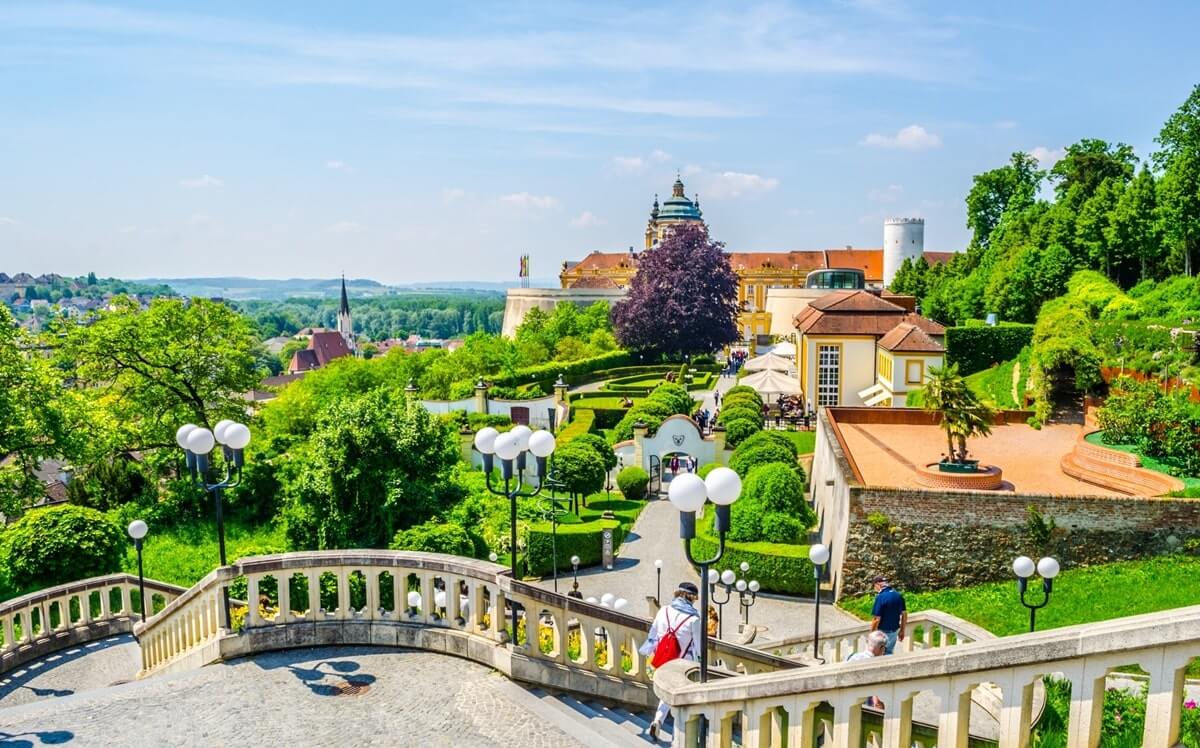Historic Monuments in the Austria
Austria's tormented history has left it with one of the most important architectural legacies of Central Europe. The country abounds in historical monuments built in different styles, with a predominance of the Baroque style, especially in Vienna. The capital city is known to be home to some of the most important monuments in the country, but the other cities are not to be outdone either. Each city and region has its own architectural gems, such as religious buildings, imperial palaces, opera houses, etc.
A little foretaste for the enthusiasts who are going to visit Austria:

Monuments of Lower Austria
- The Benedictine Abbey of Melk: famous abbey overlooking the city on the Danube. It dates back to the baroque period.
- The ruins of the fortresses of Aggstein: situated on a rocky spur, it is one of the most imposing castles in Austria.
- Fortresses of Dürnstein: once King Richard the Lionheart was imprisoned here.
- The church of Spitz, a magnificent Gothic building dating from the 15th century.
- The abbey of Dürnstein: a group of baroque buildings pleasantly situated on the banks of a river.
Monuments of Styria
- The Benedictine Abbey of Admont: it houses the largest monastic library in the world!
- The basilica of Mariazell, one of the most important places of pilgrimage in Europe.
- The castle of Eggenberg: date of the renaissance is was built by an Italian who had as a theme, the skies and the stars.
Monuments in Carinthia
- The villa Schnür: in Pörtschach on the shores of the Wörthersee lake is known for its boathouse and pillories.
- The baroque Ossiach Abbey: numerous concerts and operas take place there between May and October every year.
- Millstatt Abbey, frescoes and furniture dating from the Middle Ages, you will have a beautiful view of the peaks of the Kreuzeck and Reisseck mountains.
- The castle of Porcia: one of the most beautiful castles of the renaissance. It is located in Spittal an der Drau. Many concerts are organized there every year.
Monuments of Upper Austria
- Linz Cathedral: the largest in the country, it can hold up to 20,000 people!L
- Linz Castle: situated high above the city centre and the Danube.
- The Wilhering Abbey, a 12th century building which contains many writings from the medieval period.
- The castle of Kremsegg: it contains several objects of the musician Schubbert.
- The abbey of Saint-Florian: one of the oldest abbeys in the world still in activity.
- Mondsee monastery: very well known for its "Mondsee codex", a collection of medieval writings.
Salzburg Monuments
- Hohensalzburg Fortress: the largest perfectly preserved fortress in Central Europe.
- The Mirabell Castle: the baroque palace of the city of Salzburg.
- Leopoldskron Castle: you may have already seen it in The Sound of Music!
- St. Rupert's Cathedral in Salzburg, where Mozart himself was baptized!
Visiting Austria : Museums not to be missed
The distribution of museums in Austria is anything but fair. They are almost non-existent in small towns, while in Vienna there are about a hundred. They are a good way to discover Austria and its culture.
Among the museums in Austria we find :
- The Tyrolean Folk Art Museum in Innsbruck. Perhaps the most beautiful of its kind in Europe. Ideal to discover the cultural and domestic objects of the time.
- The Lentos museum in Linz: a museum of contemporary art, the very architecture of the place is worth a visit.
- The Salzburg museum: a museum of ancient history which has the particularity of being lively with activities.
- The Mönchsberg Museum of Modern Art, works of art from the 20th and 21st centuries by international artists.
- The Rolls Royce museum in Dornbirn, if you like cars very much!
- The Jewish Museum in Hohenems, a museum of the Jewish community in the region.
- The Landesmuseum in Carinthia, with its ethnographic institute and botanical garden.
- The Celtic Museum in Hallein: this museum contains Celtic objects that are unique in the world.
Events
On the events side, Austria boasts one of the richest cultural agendas in Europe. Alongside the many traditional festivals and the carnival season, there are also festivals. It's promising!
If you would like to set the date of your trip, depending on the season with the most cultural events, we are here to guide you. Take a look at this little glimpse of the country's cultural agenda and discover Austria and its frenzied festivals:
|
January |
Perchtenlaufen folk festival where we fight with masks, Mozart week "Mozartwoche", Carnival season |
|
March |
The Salzburg Biennale, |
|
April |
Festival Wean Hean Festival du film Crossing Europe |
|
May |
Donaufestival a music festival in Krems Klangfruhling Music Festival, the Narcissus Festival |
|
June |
Beethoven Festival, Nova Rock Festival, Danube Island Festival, Vienna Jazz Festival |
|
July |
Festival in Salzkalmergut, Fetsival Glatt & Verkerht, Music Film Festival, Fetsival Summertime Blues, pop music festival in Vienna |
|
August |
Freakwave Festival of electro music in Dornbirn, la Strada, |
|
September |
Early Music Festival, Brucknerfest Music Festival |
|
October |
Jazz & The city in Salzburg |
What is special about Austria is of course its balls. This country is one of the few in Europe to have preserved this tradition and culture over the years.
National parks and natural sites
Austria's nature is overflowing with generosity and a walk in the parks is the best way to visit Austria and discover the best that the country has to offer. Each region of the country is characterised by its own landscape, which gives it a unique charm!
Austria is, in general, a fairly green country, with many forests and green spaces, as well as several national parks, which we advise you to visit:
- Nationalpark Donau-Auen
- Nationalpark Gesäuse
- Nationalpark Hohe Tauern
- Nationalpark Kalkalpen
- Nationalpark Donau-Auen
- Nationalpark Gesäuse
- Nationalpark Hohe Tauern
- Nationalpark Kalkalpen
These parks are perfect for various activities, including hiking in the Austrian Alps. These are not the country's only natural assets. There are also a good number of lakes and other waterways, the most important of which is the Danube.
There are also many ski resorts in Austria, the most popular of which are those in the Tyrol.
Zoos and amusement parks
There are several leisure and amusement areas in Austria, but almost all of them are dedicated to children. Here are a few of them :
- Walderlebniswelt Klopeiner See
- Amusement park Urzeitwald
- Amusement park Strasswalchen
- Amusement park Fusch-Ferleiten
- Climbing park Abenteuerpark
- Hexenwasser Adventure Park
- Leisure Park Aktivpark Montafon
Zoos
There are only two large zoos in Austria: Vienna Zoo and Innsbruck Alpine Zoo.
Nightlife
You'll have no problem going out in Austria and having fun. At night, the city centres come alive and you'll have no difficulty eating in a good restaurant, drinking in a bar and dancing all night long at a ball or to the beat of the most successful hits in one of the nightclubs.
Austria's nocturnal facet is not limited to partying. In this country, cultural activities are also very popular. The dances and operas that make up an integral part of the country's culture come to mind.
Austria also stands out for its famous Heuriger. A kind of Austrian-style tavern, where wine was served at the beginning (mostly wine of the year), but now you can also enjoy good food.
Generally speaking, Vienna's nightlife is at its best, as this is where you'll find all the ingredients for a successful night out!
Good to know: never go out without an identity card if you are going to visit Austria. You will almost always be asked for it at the entrance to a bar or club.
Comparez et réservez les meilleures offres pour visiter Autriche - ENG
Enrichissez vos séjours avec des activités exceptionnelles aux côtés de guides bienveillants avec :
 OUI
OUI
 NON
NON









 Merci
Merci